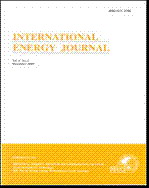ThaiScience
ThaiScience
INTERNATIONAL ENERGY JOURNAL
Volume 22, No. 03, Month SEPTEMBER, Year 2022, Pages 231 - 244
Optimal design of guide vane for improving mini hydro power plant efficiency by using twin axis vertical turbine
Kanisorn Tom Thanatwutthigorn, Ratchaphon Suntivarakorn
Abstract Download PDF
This research aimed to increase the efficiency of a pico-hydropower plant with Banki type turbines by installing a guide vane system as the inlet water control. It was observed that the inlet angle of attack and the number of turbine blades had affected the efficiency of the pico-hydropower plant. Moreover, a computational fluid dynamics (CFD) simulation was conducted for validation by creating a guide vane with inlet angles of 5 to 30 degrees and a turbine with 15–40 blades. The turbulent model in the SOLIDWORKS Simulation was selected as the fluid dynamic model. The simulation results statistically showed that the inlet angle of attack had a greater influence on the torque than the number of blades, with P-values of 1.1893x10-7 and 0.3915, respectively. The efficiency investigation using a 25-blade turbine with inlet angles of attack of 5, 10, 15, 20, 24, and 30 degrees, showed that the turbine with the 24-degree inlet angle of attack had exhibited the highest system efficiency at 45.83%. This research focused on vertical axis Banki turbine, which has been designed for electrical generation in irrigational canal only. In the practical demonstration, a 3-kW electrical generator system was installed across the canal, and the system efficiency was also investigated. The results showed that the maximum system efficiency was at 48% with a 0.7 m system head and a flow rate of 0.4 m3/s. This represents results which were higher than predicted from the simulation at 45.83% and a greater performance than that of the generating system without a guide vane at 34.96%.
Keywords
Guide vane; Hydropower; Low head; Turbine; Twin turbineINTERNATIONAL ENERGY JOURNAL
Published by : Asian Institute of Technology
Contributions welcome at : http://www.rericjournal.ait.ac.th
